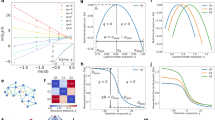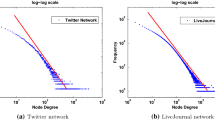Abstract
The most important structural characteristics in the study of large-scale real-world complex networks in pattern analysis are degree distribution. Empirical observations on the pattern of the real-world networks have led to the claim that their degree distributions follow, in general, a single power law. However, a closer observation, while fitting, shows that the single power-law distribution is often inadequate to meet the data characteristics properly. Since the degree distribution in the log–log scale actually displays, under inspection, two different slopes unlike what happens while fitting with the single power law. These two slopes with a transition in between closely resemble the pattern of the sigmoid function. This motivates us to derive a novel double power-law distribution for accurately modeling the real-world networks based on the sigmoid function. The proposed modeling approach further leads to the identification of a transition degree which, it has been demonstrated, may have a significant implication in analyzing the complex networks. The applicability, as well as effectiveness of the proposed methodology, is shown using rigorous experiments and also validated using statistical tests.















Similar content being viewed by others
References
Adamic LA, Huberman BA (2000) Power-law distribution of the world wide web. Science 287(5461):2115–2115
Adamic LA, Lukose RM, Puniyani AR, Huberman BA (2001) Search in power-law networks. Phys Rev E 64(4):046135
Albert R, Barabási AL (2002) Statistical mechanics of complex networks. Rev Mod Phys 74(1):47
Albert R, Jeong H, Barabási AL (2000) Error and attack tolerance of complex networks. Nature 406(6794):378
Amaral LAN, Scala A, Barthelemy M, Stanley HE (2000) Classes of small-world networks. Proc Natl Acad Sci 97(21):11149–11152
Barabasi AL (2005) The origin of bursts and heavy tails in human dynamics. Nature 435(7039):207
Barabási AL, Albert R (1999) Emergence of scaling in random networks. Science 286(5439):509–512
Bauke H (2007) Parameter estimation for power-law distributions by maximum likelihood methods. Eur Phys J B 58(2):167–173
Bollobás B, Riordan OM (2003) Mathematical results on scale-free random graphs. In: Bornholdt S, Schuster HG (eds) Handbook of graphs and networks: from the genome to the internet. Wiley, London, pp 1–34
Broder A (2000) A. Broder, R. Kumar, F. Maghoul, P. Raghavan, S. Rajagopalan, R. Stata, A. Tomkins, and J. Wiener, Comput. Netw. 33, 309. Comput Netw 33:309
Chattopadhyay S, Murthy C, Pal SK (2014) Fitting truncated geometric distributions in large scale real world networks. Theor Comput Sci 551:22–38
Choi DJ (1992) On a generalization of the hurwitz zeta function \(f (s, a)\). Indian J Pure Appl Math 23(2):83–91
Clauset A, Young M, Gleditsch KS (2007) On the frequency of severe terrorist events. J Confl Resolut 51(1):58–87
Clauset A, Shalizi CR, Newman ME (2009) Power-law distributions in empirical data. SIAM Rev 51(4):661–703
Coelho R, Richmond P, Barry J, Hutzler S (2008) Double power laws in income and wealth distributions. Phys A Stat Mech Appl 387(15):3847–3851
Goldstein ML, Morris SA, Yen GG (2004) Problems with fitting to the power-law distribution. Eur Phys J B Condens Matter Complex Syst 41(2):255–258
Guo K, Guo W, Chen Y, Qiu Q, Zhang Q (2015) Community discovery by propagating local and global information based on the mapreduce model. Inf Sci 323:73–93
Huberman BA (1999) Ba huberman and la adamic. Nature (London) 401:131
Kleinberg JM, Kumar R, Raghavan P, Rajagopalan S, Tomkins AS (1999) The web as a graph: measurements, models, and methods. In: International computing and combinatorics conference. Springer, pp 1–17
Leskovec J, Krevl A (2014) SNAP Datasets: Stanford large network dataset collection. http://snap.stanford.edu/data
Leskovec J, Chakrabarti D, Kleinberg J, Faloutsos C, Ghahramani Z (2010) Kronecker graphs: an approach to modeling networks. J Mach Learn Res 11(Feb):985–1042
Liu Y, Li C, Tang WK, Zhang Z (2012) Distributed estimation over complex networks. Inf Sci 197:91–104
Muchnik L, Pei S, Parra LC, Reis SD, Andrade JS Jr, Havlin S, Makse HA (2013) Origins of power-law degree distribution in the heterogeneity of human activity in social networks. Sci Rep 3:1783
Newman ME (2001) The structure of scientific collaboration networks. Proc Natl Acad Sci 98(2):404–409
Newman ME (2003) The structure and function of complex networks. SIAM Rev 45(2):167–256
Newman ME (2005) Power laws, Pareto distributions and Zipf’s law. Contemp Phys 46(5):323–351
Newman ME, Strogatz SH, Watts DJ (2001) Random graphs with arbitrary degree distributions and their applications. Phys Rev E 64(2):026118
Pennock DM, Flake GW, Lawrence S, Glover EJ, Giles CL (2002) Winners don’t take all: characterizing the competition for links on the web. Proc Natl Acad Sci 99(8):5207–5211
Richmond P, Hutzler S, Coelho R, Repetowicz P (2006) A review of empirical studies and models of income distributions in society. Wiley, Berlin
Rossi RA, Ahmed NK (2015) The network data repository with interactive graph analytics and visualization. In: Proceedings of the twenty-ninth AAAI conference on artificial intelligence. http://networkrepository.com
Sala A, Zheng H, Zhao BY, Gaito S, Rossi GP (2010) Brief announcement: revisiting the power-law degree distribution for social graph analysis. In: Proceedings of the 29th ACM SIGACT-SIGOPS symposium on Principles of distributed computing. ACM, pp 400–401
Seal H (1952) The maximum likelihood fitting of the discrete Pareto law. J Inst Actuar 78(1):115–121
Seshadri M, Machiraju S, Sridharan A, Bolot J, Faloutsos C, Leskove J (2008) Mobile call graphs: beyond power-law and lognormal distributions. In: Proceedings of the 14th ACM SIGKDD international conference on Knowledge discovery and data mining. ACM, pp 596–604
Song Y, Zhang C, Wu M (2010) The study of human behavior dynamics based on blogosphere. In: 2010 International conference on web information systems and mining (WISM), vol 1. IEEE, pp 87–91
Sun PG, Gao L, Han SS (2011) Identification of overlapping and non-overlapping community structure by fuzzy clustering in complex networks. Inf Sci 181(6):1060–1071
Toda AA (2012) The double power law in income distribution: explanations and evidence. J Econ Behav Organ 84(1):364–381
Yang J, Leskovec J (2015) Defining and evaluating network communities based on ground-truth. Knowl Inf Syst 42(1):181–213
Acknowledgements
The authors gratefully acknowledge the financial assistance received from Indian Statistical Institute (I. S. I.) and Visvesvaraya PhD Scheme awarded by the Government of India.
Author information
Authors and Affiliations
Corresponding author
Additional information
Publisher's Note
Springer Nature remains neutral with regard to jurisdictional claims in published maps and institutional affiliations.
Electronic supplementary material
Below is the link to the electronic supplementary material.
Rights and permissions
About this article
Cite this article
Chattopadhyay, S., Das, A.K. & Ghosh, K. Finding patterns in the degree distribution of real-world complex networks: going beyond power law. Pattern Anal Applic 23, 913–932 (2020). https://doi.org/10.1007/s10044-019-00820-4
Received:
Accepted:
Published:
Issue Date:
DOI: https://doi.org/10.1007/s10044-019-00820-4




